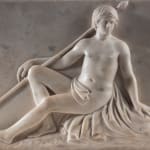Neo-Classical Tablet
A George III Statutory Marble Chimneypiece Tablet, Circa 1770
English, in the manner of John Deere (1759-1798).
Provenance: Private Collection (United Kingdom).
Height: 20cm Width: 47cm Depth: 5.5cm
A finely carved neoclassical marble tablet depicting a reclining youth holding a thyrsus, the vine-wreathed staff associated with Bacchus, approached by a younger attendant offering wine from a jug beside a krater. The elegant handling of anatomy and drapery reflects the influence of antique Roman reliefs and the refined modelling found in the work of John Deare and his contemporaries in late 18th century Rome.
The scene likely alludes to the cult of Bacchus or an Arcadian pastoral, evoking themes of leisure, youth and divine intoxication. The poised yet relaxed distortion of the seated figure, coupled with the clean, restrained ground line and minimal background detail, marks this as a composition rooted in the neoclassical revival of antique prototypes.
Closely related are a number of chimney tablets attributed to British sculptors working in Italy in the 1770s-80s, including reliefs designed by or influenced by Deare, Flaxman, or members of the Carter workshop, adapting classical sources for the flourishing English market.
English, in the manner of John Deere (1759-1798).
Provenance: Private Collection (United Kingdom).
Height: 20cm Width: 47cm Depth: 5.5cm
A finely carved neoclassical marble tablet depicting a reclining youth holding a thyrsus, the vine-wreathed staff associated with Bacchus, approached by a younger attendant offering wine from a jug beside a krater. The elegant handling of anatomy and drapery reflects the influence of antique Roman reliefs and the refined modelling found in the work of John Deare and his contemporaries in late 18th century Rome.
The scene likely alludes to the cult of Bacchus or an Arcadian pastoral, evoking themes of leisure, youth and divine intoxication. The poised yet relaxed distortion of the seated figure, coupled with the clean, restrained ground line and minimal background detail, marks this as a composition rooted in the neoclassical revival of antique prototypes.
Closely related are a number of chimney tablets attributed to British sculptors working in Italy in the 1770s-80s, including reliefs designed by or influenced by Deare, Flaxman, or members of the Carter workshop, adapting classical sources for the flourishing English market.







